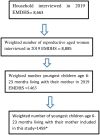Zero fruits/vegetables consumption and associated factors among Children aged 6-23 months in Ethiopia: Mixed effect logistic regression analysis
- PMID: 37450483
- PMCID: PMC10348598
- DOI: 10.1371/journal.pone.0288732
Zero fruits/vegetables consumption and associated factors among Children aged 6-23 months in Ethiopia: Mixed effect logistic regression analysis
Abstract
Background: The first two years of life is a vital period for promoting optimal growth, development and health. The lifelong nutritional habit and overall health of children is influenced by their early age feeding practice. Ethiopia is among the top five countries in Sub-Saharan Africa with the highest burden of zero fruits/vegetables consumption. This study aims to access factors associated with zero fruits/vegetables consumption among children aged 6-23 months in Ethiopia.
Methods: The study analyzed Ethiopian Mini Demographic and Health Survey 2019 dataset with a total weighted sample of 1459 young children aged between 6-23 months and who were living with their mothers. Data cleaning, coding and labeling were done using STATA version 14 software. Multilevel mixed effect logistic regression model was employed to identify associated factors.
Results: Exactly 69.3% of children aged 6-23 months in Ethiopia had zero fruits/vegetables consumption. In the multivariable multilevel binary logistic regression analysis a child from household with middle (AOR = 0.55, 95% CI: 0.35, 0.86) and rich (AOR = 0.37, 95% CI: 0.23, 0.60) wealth index, mothers who aged between 25-34 years old (AOR = 0.44; 95%CI = 0.29-0.69), mothers who were married/living with partner (AOR = 3.21; 95%CI: 1.58-6.52), children of mothers who follow Islamic religion (AOR = 0.34, 95% CI: 0.19, 0.61), mothers who had more than four ANC visits during their most recent pregnancy (AOR = 0.57; 95%CI: 0.39-0.83), children in age group of 12-18 month(AOR = 0.41, 95% CI: 0.28, 0.59), and 19-23 months (AOR = 0.26, 95% CI: 0.17, 0.40), health facility delivery (AOR = 1.52, 95% CI; 1.00-2.30), and small peripheral regions (AOR = 4.40, 95% CI; 1.39-13.97) were found to be significant factors associated with children's zero fruits /vegetables consumption. The Interclass correlation coefficient (ICC) value in the null model was 0.34, which indicates that 34% of the variation in children's zero fruits /vegetables consumption was attributed to the variation between clusters.
Conclusion: This study found that zero fruits/vegetables consumption among children aged 6-23 months in Ethiopia is high. Therefore, efforts should be made by stakeholders who are concerned about optimal diet and health of children to improve fruits/vegetables consumption of children particularly those from poor households, young mothers (15-24), and peripheral regions of Ethiopia. This could be done during ANC follow up visits and during nutrition counseling.
Copyright: © 2023 Semagn, Abubakari. This is an open access article distributed under the terms of the Creative Commons Attribution License, which permits unrestricted use, distribution, and reproduction in any medium, provided the original author and source are credited.
Conflict of interest statement
The authors have declared that no competing interests exist.
Figures

References
-
- Romero-Velarde E, Villalpando-Carrión S, Pérez-Lizaur AB, Iracheta-Gerez MdlL, Alonso-Rivera CG, López-Navarrete GE, et al.. Guidelines for complementary feeding in healthy infants. Boletín Médico Del Hospital Infantil de México (English Edition). 2016;73(5):338–56. - PubMed
-
- Riley LK, Rupert J, Boucher O. Nutrition in Toddlers. American family physician. 2018;98(4):227–33. - PubMed
-
- Amiot-Carlin MJ. [Fruit and vegetable consumption: what benefits, what risks?]. La Revue du praticien. 2019;69(2):139–42. - PubMed
MeSH terms
LinkOut - more resources
Full Text Sources

